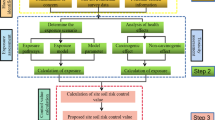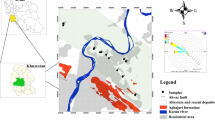Abstract
Oil-based drilling cutting residues (OBDCRs) contain many kinds of carcinogenic contaminants, such as heavy metal elements, polycyclic aromatic hydrocarbons (PAHs), and natural radioactive materials (NORMs), which are great risks for the environment and human health. This study investigated the chemical composition, the radioactive strength, the heavy metal contents, and the org matter contents in OBDCRs and estimated the health risks due to exposure to heavy metals, PAHs, and radionuclides in OBDCRs used for roadbed materials. From the measurements, it was found that the content values of benzopyrene (a), diphenylanthracene (a, h), and petroleum hydrocarbons exceeded the standard limit. The content values of Cu, Zn, As, and Ni were higher than 50% of the standard limit. If OBDCRs were directly used to make roadbed materials, the total carcinogenic risk values (CRn) of As, benzoanthracene (a), benzopyrene (a), and dibenzoanthracene (a, h) were all higher than 10−6. The average absorbed dose rate was higher than 80 nGy/h. There were greater risks of carcinogenic environment and potential harms to human health. To reduce the health risks, it is necessary to consider the strategy of the utilization of OBDCRs, the working time, and the service life of the recycled OBDCRs and establish a legal standard and liability for the utilization of OBDCRs as solid waste resources.








Similar content being viewed by others
References
Ball AS, Stewart RJ, Schliephake K (2012) A review of the current options for the treatment and safe disposal of drill cuttings. Waste Manag Res 30(5):457–473
Bernardo G, Marroccoli M, Nobili M, Telesca A, Valenti GL (2007) The use of oil well-derived drilling waste and electric arc furnace slag as alternative raw materials in clinker production. Resour Conserv Recycl 52:95–102
Chen H, Teng Y, Lu S, Wang Y, Wu J, Wang J (2016) Source apportionment and health risk assessment of trace metals in surface soils of Beijing metropolitan, China. Chemosphere 144:1002–1011
China, Chongqing Administration of Quality and Technology Supervision (2016) Technical guidelines for site environmental investigation and risk assessment, DB50/T 725-2016
China, Ministry of ecology and environment (2019) Annual report of the national radiation environment, Beijing, 55-56
China, Ministry of ecology and environment, State Administration of market supervision and Administration (2018a) Soil environmental quality standard -Risk control standard of agricultural land soil pollution (Trial), GB15618-2018
China, Ministry of ecology and environment, State Administration of market supervision and Administration (2018b) Soil environmental quality standard –Risk control standards for soil pollution of construction land (Trial), GB36600-2018
China, Ministry of environmental protection (2014) Technical guidelines for risk assessment of contaminated sites, HJ 25.3-2014
China, Ministry of environmental protection (2016 National hazardous waste list, 000014672/2016-00564
China, Ministry of environmental protection, State Administration of market supervision and Administration (2007a) Identification standards for hazardous wastes-Identification for toxic substance content, GB 5085.6-2007
China, Ministry of environmental protection, State Administration of market supervision and Administration (2007b) Identification standards for hazardous wastes-General specifications, GB 5085.7-2007
China, Ministry of transport (2015) Technical guidelines for construction of highway roadbases. JTG/T F20-2015
China, State Environmental Protection Administration (1998) Technical specifications on sampling and sample preparation from industry solid waste, HJ/T 20-1998
Gillis BS, Arbieva Z, Gavin IM (2012) Analysis of lead toxicity in human cells. BMC Genomics 13:344
Jagwani D, Shukla P, Kulkarni A et al (2011) Organ Specific Distribution of PAHs in a Carnivorous Fish Species Following Chronic Exposure to Used Synthetic-Based Drilling Mud[J]. Polycycl Aromat Compd 31(4):227–242
Joel ES, Maxwell O, Adewoyin OO et al (2018) Comparative Analysis of Natural Radioactivity Content in Tiles made in Nigeria and Imported Tiles from China. Sci Rep 8:1842. https://doi.org/10.1038/s41598-018-20309-0
Jones FV, Rushing JH, Churan MA (1991) The chronic toxicity of mineral oil wet and synthetic liquid wet cuttings on an estuarine fish[C]. SPE Health ,Safety and Environment in Oil and Gas Exploration and Production Conference. The Hague. https://doi.org/10.2118/23497-MS
Lin L, Xu Y, Zhang JC et al (2019) Risk analysis of shale gas exploration and development. China Min Mag 11:59–64
Lippmann M, Ito K, Hwang JS et al (2006) Cardiovascular effects of nickel in ambient air. Environ Health Perspect 114:166214–166216
Liu X, Song Q, Tang Y et al (2013) Human health risk assessment of heavy metals in soil-vegetable system: a multi-medium analysis. Sci Total Environ 463–464:530–540
Shen P, Zhu HY, Xu YC (1983) Distribution characteristics of uranium, thorium and potassium in sedimentary rocks. Acta Sedimentol Sin 1(3):109–122
Soeder DJ, Sharma S, Pekney N, Hopkinson L, Dilmore R, Kutchko B, Stewart B, Carter K, Hakala A, Capo R (2014) An approach for assessing engineering risk from shale gas wells in the United States. Int J Coal Geol 126:4–19
UNSCEAR (United Nations Scientific Committee on the Effects of Atomic Radiation) (1998) Sources, Efects and Risks of Ionizing Radiations. United Nations, New York, pp 1–7
Wang CQ, Lin XY, Zhang C, Mei XD (2017a) Environmental Security Control of Resource Utilization of Shale gas’ Drilling Cuttings Containing heavy metals. Environ Sci Pollut Res 27:21973–21983
Wang CQ, Jin JZ, Lin XY, Xiong DM, Mei XD (2017b) A Study on the Oil-based Drilling Cuttings Pyrolysis Residues Resource Utilization by the Exploration and Development of Shale gas. Environ Sci Pollut Res 24(21):17816–17828
Wang HL, Rao W, Luo MD, Yu Q (2019) Investigation on Natural Radioactivity Level of Wastewater from Shale Gas Exploitation in Longmaxi Formation of Sichuan Basin. Sichuan Environ 38(2):86–89
Xiong DM, Liao P, Fang JY, Wang CQ, Xu FL, Liu P (2019) Experimental Study on Preparation of Porous Ceramsite with Oil-based Drilling Cuttings. Environ Pollut Control 41(Supplement 1):25–27
Xu H, Han S, Bi X, Zhao Z, Zhang L, Yang W, Zhang M, Chen J, Wu J, Zhang Y, Feng Y (2016) Atmospheric metallic and arsenic pollution at an offshore drilling platform in the Bo Sea: a health risk assessment for the workers. J Hazard Mater 304:93–102
Xu TT, Wang LA, Wang X, Li T, Zhan XY (2018) Heavy metal pollution of oil-based drill cuttings at a shale gas drilling field in Chongqing, China: A human health risk assessment for the workers. Ecotoxicol Environ Saf 165:160–163
Zhang L, Ye F, Wang J et al (2015) The eco-environmental characteristics and variation trends around Chengdao oil field sea areas in the Yellow River Estuary. J Mar Sci 33(3):75–83
Acknowledgements
Thanks to Dr. Chaoqiang Wang and the reviewers for their valuable opinions, which greatly improved the quality of the paper.
Funding
This research was supported by “Study on raw material substitution technology for monitoring and evaluation of drilling cuttings landfill tank and collaborative disposal of landfill body cement kiln” (Grant No. cstc2019jcyj-msxmX0651).
Availability of data and materials
All data generated or analyzed during this study are included in this published article.
Author information
Authors and Affiliations
Contributions
De-ming Xiong: framework design and experiments, data and relevant mechanism analysis, writing—original draft, and writing—review, revised, and editing.
Chao-qiang Wang: assisting with research, experiments, and data analysis.
Corresponding author
Ethics declarations
Ethical approval
Any experimental research on animals should follow the internationally recognized guidelines. However, in this study, we did not conduct any human or animal experiments, so we do not need the moral consent of the relevant departments.
Consent to participate
Nobody participated in the human or animal experiment.
Consent for publication
All authors agreed to publish the article.
Competing interests
The authors declare no competing interests.
Additional information
Responsible Editor: Lotfi Aleya
Publisher’s note
Springer Nature remains neutral with regard to jurisdictional claims in published maps and institutional affiliations.
Rights and permissions
About this article
Cite this article
Xiong, D., Wang, C. Risk assessment of human exposure to heavy metals, polycyclic aromatic hydrocarbons, and radionuclides in oil-based drilling cutting residues used for roadbed materials in Chongqing, China. Environ Sci Pollut Res 28, 48171–48183 (2021). https://doi.org/10.1007/s11356-021-13871-0
Received:
Accepted:
Published:
Issue Date:
DOI: https://doi.org/10.1007/s11356-021-13871-0




